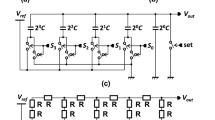Abstract
An analog electronic neuron for modeling neuronal networks and for teaching purposes is presented. The circuitry represents a new approach, since ionic channels are all modeled by fast relay switches in combination with resistors. Thus, the synapse design includes nonlinear PSP superposition and reversal potentials. The spike is modeled with Na+ and K+ currents. Detailed circuit diagrams and examples of performance are given. Besides its use in network research, the model has been successfully used over 3 years of teaching practice.
Similar content being viewed by others
References
Basse-Lüsebrink B, Lorenz R (1984) Bau und Betrieb eines elektronischen Nervenfunktionsmodelles. Prax Naturwiss 5:135–140
Eilts-Grimm K, Wiese K (1984) An electrical analogue model for frequency dependent lateral inhibition refering to the omega neurons in the auditory pathway of the cricket. Biol Cybern 51:45–52
French AS, Stein RB (1970) Flexible neural analog using integrated circuits. IEEE Transa Biomed Eng BME 17:248–253
Friesen WO, Stent GS (1977) Generation of a locomotory rhythm by a neural network with recurrent cyclic inhibition. Biol Cybern 28:27–40
Friesen WO, Wyman RJ (1980) Analysis ofDrosophila motor neuron activity patterns with neural analogs. Biol Cybern 38:41–50
Friesen WO, Poon M, Stent GS (1976) An oscillatory neuronal circuit generating a locomotory rhythm. Proc Natl Acad Sci USA 73:3734–3738
Hopfield JJ, Tank DW (1985) “Neural” computation of decisions in optimization problems. Biol Cybern 52:141–152
Jenik F (1962) Electronic neuron models as an aid to neurophysiological research. Ergeb Biol 25:206–245
Klein M, Shapiro E, Kandel ER (1980) Synaptic plasticity and the modulation of the Ca2+ current. J Exp Biol 89:117–157
Kling U, Székely G (1968) Simulation of rhythmic nervous activities. I. Function of networks with cyclic inhibitions. Kybernetik 5:89–103
Laug A, Matzat K (1980) Der Einsatz eines elektronischen Neuronenmodells im Unterricht. Biologieunterricht 16: 77–96
Lewis ER (1968) Using electronic circuits to model simple neuroelectric interactions. Proc IEEE 56:931–949
MacGregor RJ, Lewis ER (1977) Neural coding: models of electrical signal processing. In: Neural modeling. Plenum Press, New York London, pp 193–224
MacGregor RJ, Oliver RM (1974) A model for repetitive firing in neurons. Kybernetik 16:53–64
Mitchell CE, Friesen WO (1981) A neuromine system for neural circuit analysis. Biol Cybern 40:127–137
Scott PD (1977) A simple hardware model neurone. Proc Physiol Soc 269:19–20
Tuckwell HC (1986) On shunting inhibition. Biol Cybern 55:83–90
Weber T (1974) Elektrophysiologische Untersuchungen zur Entwicklung und zum Verlauf von Verhaltensweisen beiGryllus campestris L. Dissertation, Universität Köln
Wilson DM, Waldron I (1968) Models for the generation of the motor output pattern in flying locusts. Proc IEEE 56:1058–1064
Author information
Authors and Affiliations
Rights and permissions
About this article
Cite this article
Koch, U.T., Brunner, M. A modular analog neuron-model for research and teaching. Biol. Cybern. 59, 303–312 (1988). https://doi.org/10.1007/BF00332920
Received:
Published:
Issue Date:
DOI: https://doi.org/10.1007/BF00332920




